Vehicle Detection for Unmanned Systems Based on Multimodal Feature Fusion
Abstract
:1. Introduction
2. Data Collection
2.1. Algorithm Framework and Data Collection Platform
2.2. Millimeter-Wave Radar and Camera Joint Calibration
2.3. Statistical Filtering Pre-Processing
3. 3D Vehicle-Detection Algorithm
3.1. General Idea of the Algorithm
3.2. Multimodal Feature Fusion Module
3.3. Checkbox Generation Module
4. Experimental Results and Analysis
4.1. Platform and Parameters
4.2. Experimental Results
5. Conclusions
Author Contributions
Funding
Institutional Review Board Statement
Informed Consent Statement
Conflicts of Interest
References
- Cai, P.D.; Wang, S.K. Probabilistic end-to-end vehicle navigation in complex dynamic environments with multimodal sensor fusion. IEEE Robot. Autom. Lett. 2020, 5, 4218–4224. [Google Scholar] [CrossRef]
- Liu, Y.X.; Wu, X.; Xue, G. Real-time detection of road traffic signs based on deep learning. J. Guangxi Norm. Univ. (Nat. Sci. Ed.) 2020, 38, 96–106. [Google Scholar]
- Zhang, Y.; Song, B. Vehicle tracking using surveillance with multimodal data fusion. IEEE Trans. Intell. Transp. Syst. 2018, 19, 2353–2361. [Google Scholar] [CrossRef] [Green Version]
- Stanislas, L.; Dunbabin, M. Multimodal sensor fusion for robust obstacle detection and classification in the maritime RobotX challenge. IEEE J. Ocean. Eng. 2019, 44, 343–351. [Google Scholar] [CrossRef] [Green Version]
- Xie, D.S.; Xu, Y.C. 3D LIDAR-based obstacle detection and tracking for unmanned vehicles. Automot. Eng. 2020, 56, 165–173. [Google Scholar]
- Xue, P.L.; Wu, W. Real-time target recognition of urban autonomous vehicles based on information fusion. J. Mech. Eng. 2020, 56, 165–173. [Google Scholar]
- Zheng, S.W.; Li, W.H. Vehicle detection in traffic environment based on laser point cloud and image information fusion. J. Instrum. 2019, 40, 143–151. [Google Scholar]
- Wang, G.J.; Wu, J. 3D vehicle detection with RSU LiDAR for autonomous mine. IEEE Trans. Veh. Technol. 2021, 70, 344–355. [Google Scholar] [CrossRef]
- Dai, D.Y.; Wang, J.K. Image guidance based 3D vehicle detection in traffic scene. Neurocomputing 2021, 428, 1–11. [Google Scholar] [CrossRef]
- Chen, L.; Si, Y.W. 3D LiDAR-based driving boundary detection of unmanned vehicles in mines. J. Coal 2020, 45, 2140–2146. [Google Scholar]
- Choe, J.S.; Joo, K.D. Volumetric propagation network: Stereo-LiDAR fusion for long-range depth estimation. IEEE Robot. Autom. Lett. 2021, 6, 4672–4679. [Google Scholar] [CrossRef]
- Zhang, C.L.; Li, Y.R. A chunking tracking algorithm based on kernel correlation filtering and feature fusion. J. Guangxi Norm. Univ. (Nat. Sci. Ed.) 2020, 38, 12–23. [Google Scholar]
- Nie, J.; Yan, J. A multimodality fusion deep neural network and safety test strategy for inelligent vehicles. IEEE Trans. Intell. Veh. 2021, 6, 310–322. [Google Scholar] [CrossRef]
- Zhang, X.Y.; Li, Z.W. Channel attention in LiDAR-camera fusion for lane line segmentation. Pattern Recognit. 2021, 118, 108020. [Google Scholar] [CrossRef]
- Wang, X.; Li, K.Q. Intelligent vehicle target parameter identification based on 3D LiDAR. Automot. Eng. 2016, 38, 1146–1152. [Google Scholar]
- Li, M.L.; Wang, L. Point cloud plane extraction using octonionic voxel growth. Opt. Precis. Eng. 2018, 26, 172–183. [Google Scholar]
- Wu, Y.H.; Liang, H.W. Adaptive threshold lane line detection based on LIDAR echo signal. Robotics 2015, 37, 451–458. [Google Scholar]
- Chen, Z.Q.; Zhang, Y.Q. An improved DeepSort target tracking algorithm based on YOLOv4. J. Guilin Univ. Electron. Sci. Technol. 2021, 41, 140–145. [Google Scholar]
- Ding, M.; Jiang, X.Y. A monocular vision-based method for scene depth estimation in advanced driver assistance systems. J. Opt. 2020, 40, 1715001. [Google Scholar]
- Peng, B.; Cai, X.Y. Vehicle recognition based on morphological detection and deep learning for overhead video. Transp. Syst. Eng. Inf. 2019, 19, 45–51. [Google Scholar]
- Cheng, H.B.; Xiong, H.M. YOLOv3 vehicle recognition method based on CIoU. J. Guilin Univ. Electron. Sci. Technol. 2020, 40, 429–433. [Google Scholar]
- Zhao, X.M.; Sun, P.P. Fusion of 3D LIDAR and camera data for object detection in autonomous vehicle applications. IEEE Sens. J. 2020, 20, 4901–4913. [Google Scholar] [CrossRef] [Green Version]
- Zhe, T.; Huang, L.Q. Inter-vehicle distance estimation method based on monocular vision using 3D detection. IEEE Trans. Veh. Technol. 2020, 69, 4907–4919. [Google Scholar] [CrossRef]
- Pourmohamad, T.; Lee, H.K.H. The statistical filter approach to constrained optimization. Technometrics 2020, 62, 303–312. [Google Scholar] [CrossRef]
- He, K.M.; Zhang, X.Y. Deep residual learming for image recognition. In Proceedings of the 2016 IEEE Conference on Computer Vision and Patten Recognition (CVPR), Las Vegas, NV, USA, 26 June–1 July 2016. [Google Scholar]
- Lin, T.Y.; Dollár, P.; Girshick, R.; He, K.; Hariharan, B.; Belongie, S. Feature pyramid networks for object detection. In Proceedings of the 2017 IEEE Conference on Computer Vision and Pattern Recognition (CVPR), Honolulu, Hawaii, 21–26 July 2017. [Google Scholar]
- Geiger, A.; Lenz, P. Vision meets robotics: The KITTI dataset. Int. J. Robot. Res. 2013, 32, 1231–1237. [Google Scholar] [CrossRef] [Green Version]

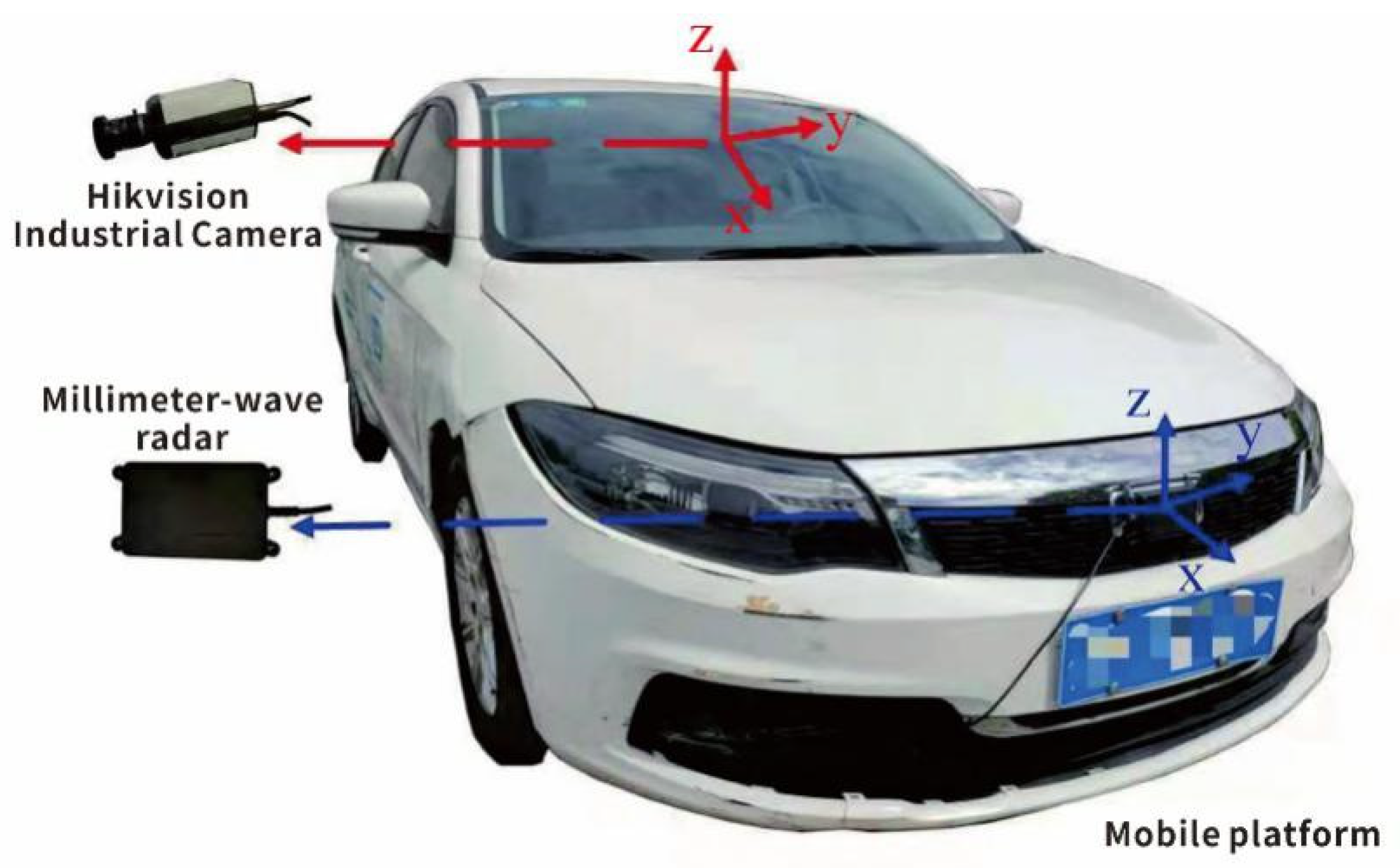
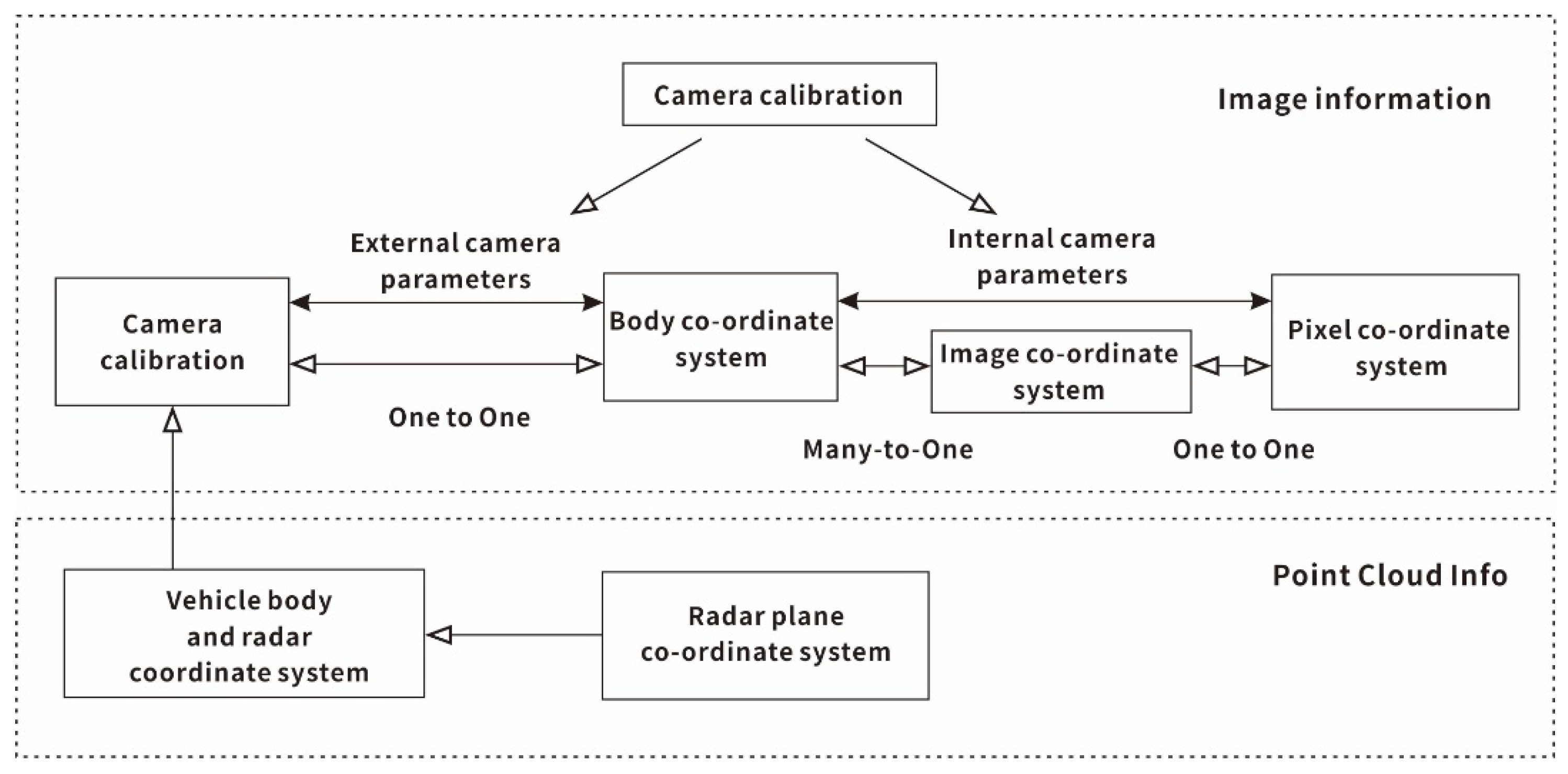
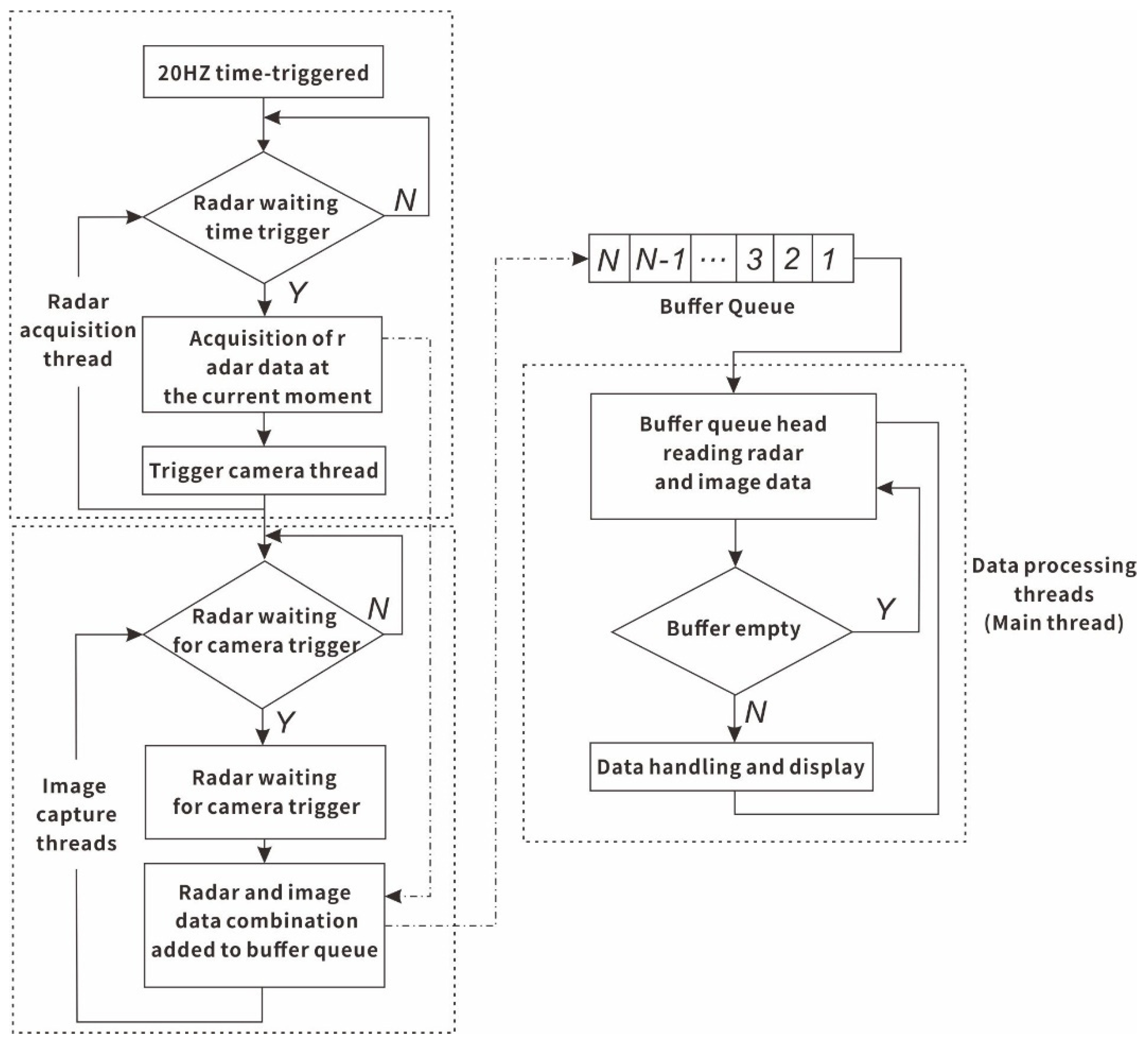
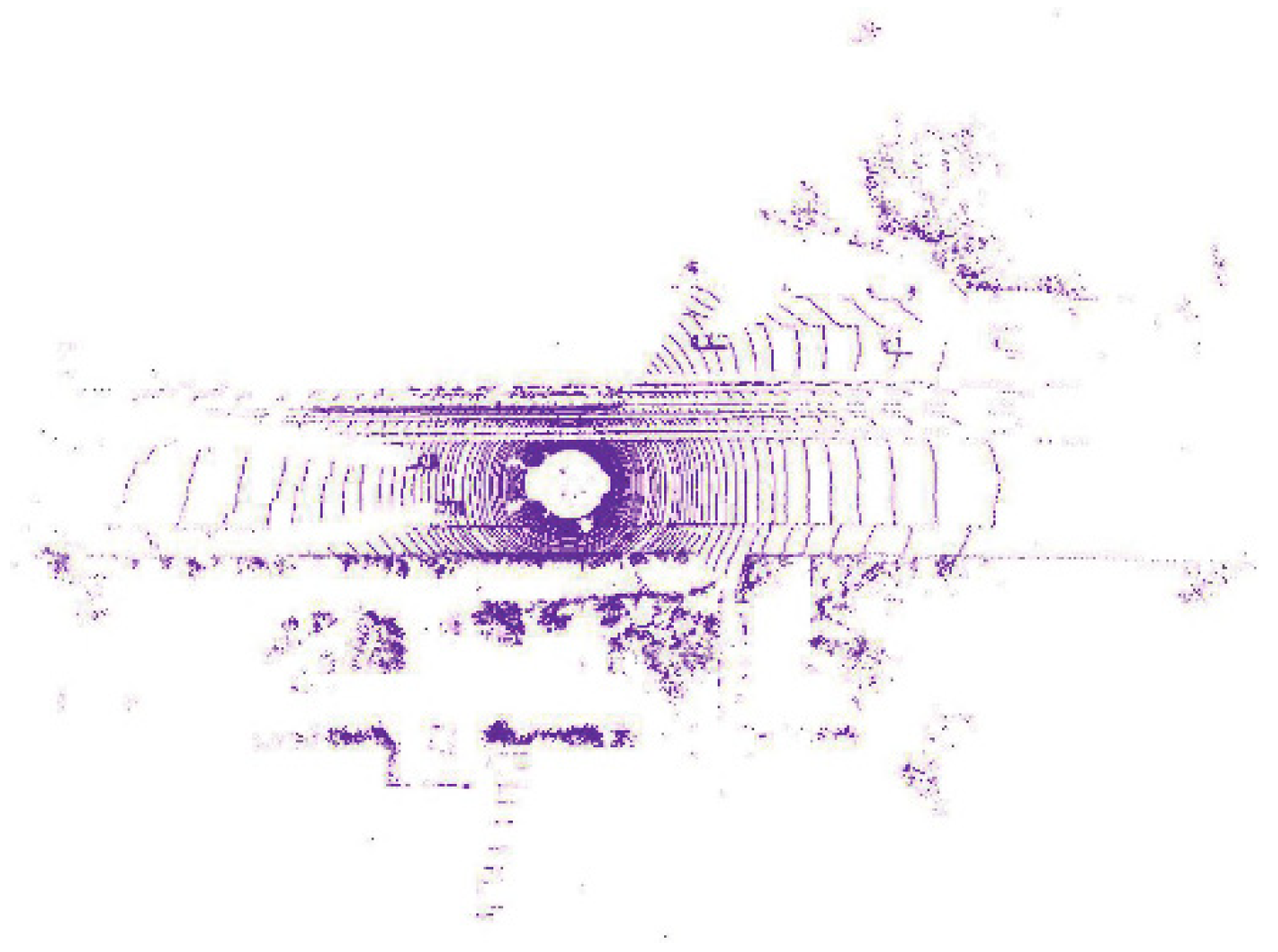

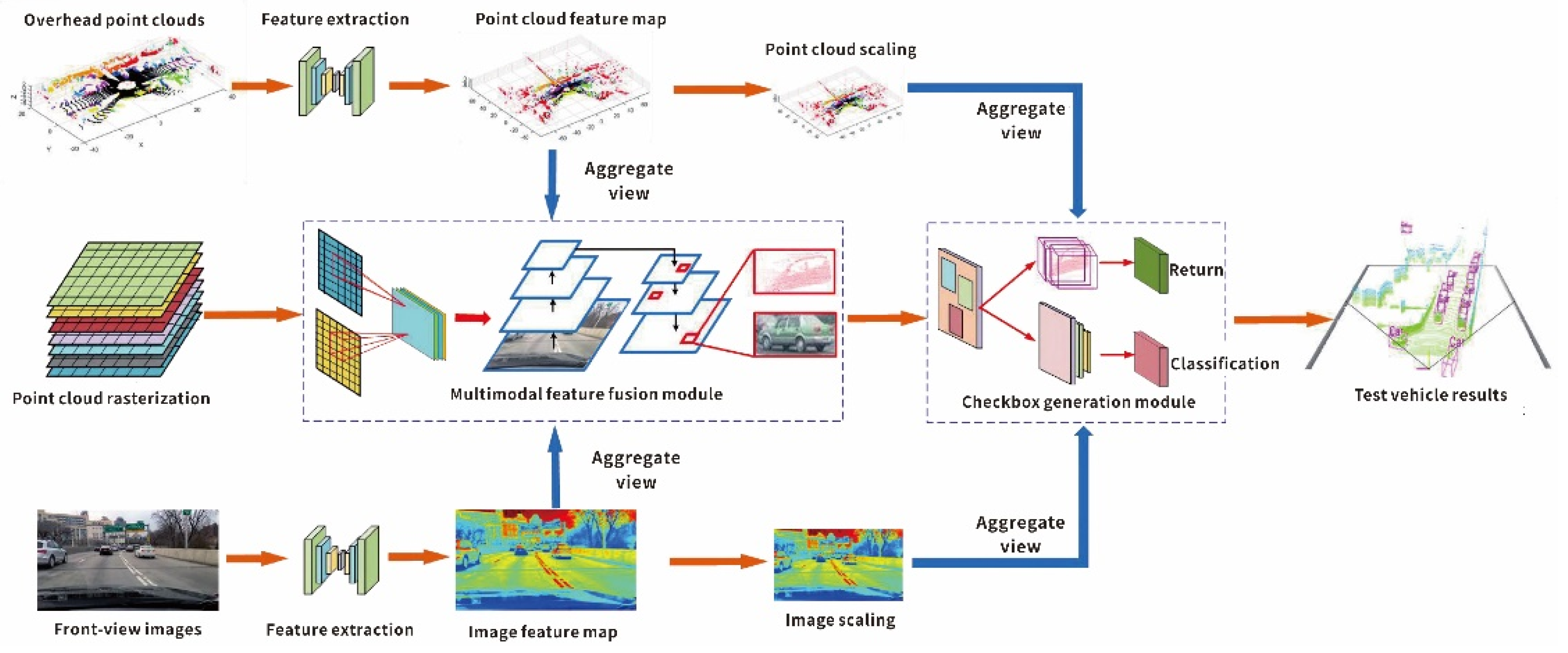
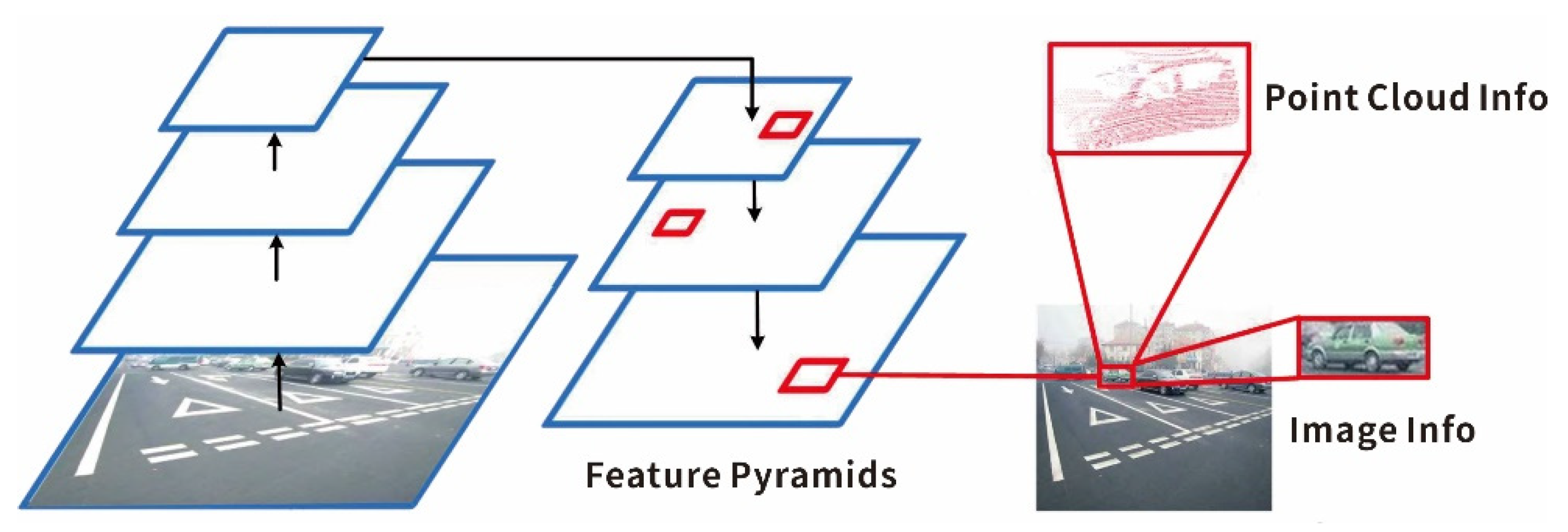
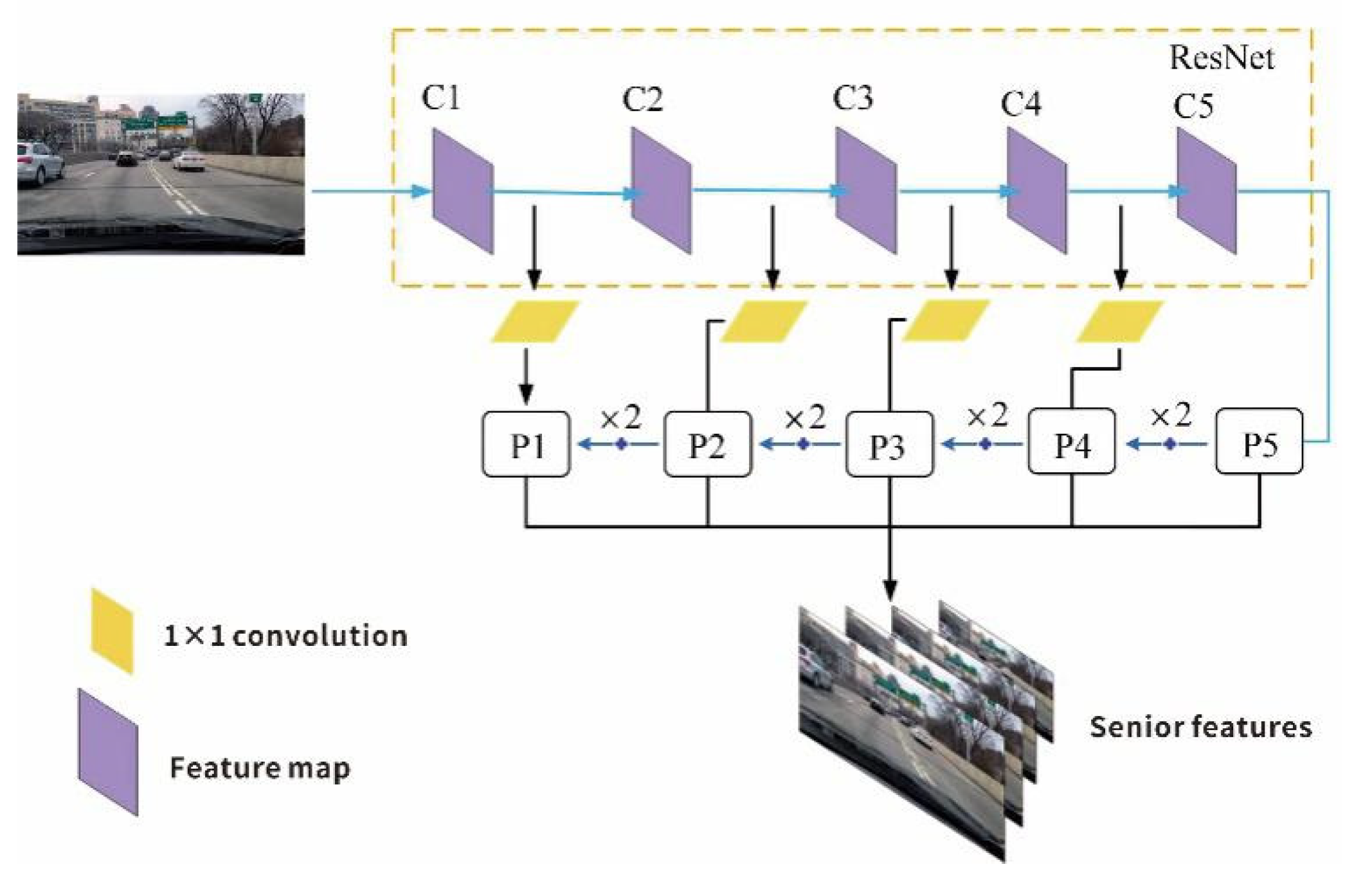





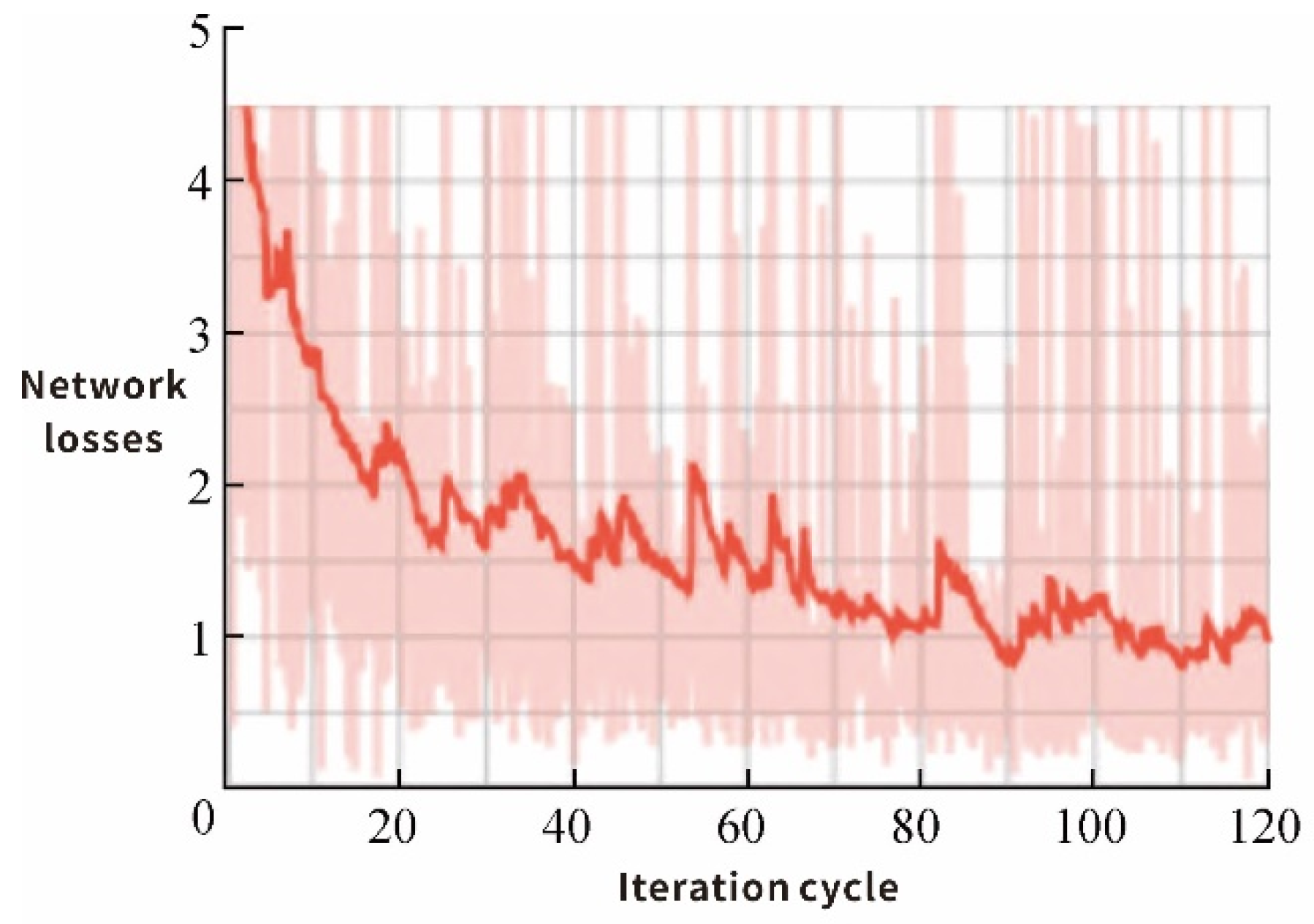

| Training Cycles | Network Losses | Testing Accuracy% |
|---|---|---|
| 60 | 1.652 | 73.32 |
| 80 | 1..271 | 79.46 |
| 100 | 1.393 | 83.84 |
| 120 | 1.132 | 84.71 |
| Testing Methods | Algorithms | Precision% | Time/s | Average Accuracy% | ||
|---|---|---|---|---|---|---|
| Simple | General | Difficulties | ||||
| Raw point cloud method | Complexer-YOLO | 24.27 | 18.53 | 17.31 | 0.09 | 20.04 |
| 3DSSD | 88.36 | 79.57 | 74.55 | 0.10 | 80.83 | |
| VOXEL3D | 86.45 | 77.69 | 72.20 | 0.24 | 78.78 | |
| Multi-view approach | SARPNET | 85.63 | 76.64 | 71.31 | 0.12 | 77.86 |
| SIE Net | 88.22 | 81.71 | 77.22 | 0.15 | 82.38 | |
| MVOD | 88.53 | 80.01 | 77.24 | 0.16 | 81.93 | |
| Image point cloud fusion methods | F-PointNet | 82.19 | 69.79 | 60.59 | 0.17 | 70.86 |
| AVOD | 83.07 | 71.76 | 65.73 | 0.22 | 73.52 | |
| MV3D | 74.97 | 63.63 | 54.00 | 0.36 | 64.20 | |
| Text Algorithms | 88.75 | 85.52 | 79.86 | 0.14 | 84.71 | |
Publisher’s Note: MDPI stays neutral with regard to jurisdictional claims in published maps and institutional affiliations. |
© 2022 by the authors. Licensee MDPI, Basel, Switzerland. This article is an open access article distributed under the terms and conditions of the Creative Commons Attribution (CC BY) license (https://creativecommons.org/licenses/by/4.0/).
Share and Cite
Wang, Y.; Liu, H.; Chen, N. Vehicle Detection for Unmanned Systems Based on Multimodal Feature Fusion. Appl. Sci. 2022, 12, 6198. https://doi.org/10.3390/app12126198
Wang Y, Liu H, Chen N. Vehicle Detection for Unmanned Systems Based on Multimodal Feature Fusion. Applied Sciences. 2022; 12(12):6198. https://doi.org/10.3390/app12126198
Chicago/Turabian StyleWang, Yuli, Hui Liu, and Nan Chen. 2022. "Vehicle Detection for Unmanned Systems Based on Multimodal Feature Fusion" Applied Sciences 12, no. 12: 6198. https://doi.org/10.3390/app12126198
APA StyleWang, Y., Liu, H., & Chen, N. (2022). Vehicle Detection for Unmanned Systems Based on Multimodal Feature Fusion. Applied Sciences, 12(12), 6198. https://doi.org/10.3390/app12126198





